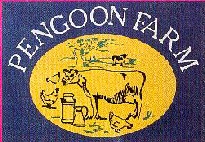

Pengoon Farm, Nancegollan, Helston, Cornwall
© Pengoon Farm 2000 - 2016
Web site by Amdow Web Design


Isles of Scilly
30 miles (a couple of hours or more) west from Pengoon Farm
Population 2,153
A semi-tropical group of around 140 islands off the south western tip of England. Access from the mainland is by steamship (the Scillonian III), by airbus or by helicopter. Coach tours around St Marys are run by Island Rover.
Only five of the islands are permanently populated.
No visit to the islands is complete without visiting Tresco Abbey Gardens on the island of Tresco.
The seas surrounding Scilly are littered with shipwrecks and many stories abound of the bravery of the islanders who rescued hundreds from drowning. Some of the stories are retold on The Tresco Times website.
For daily news and events on the Isles Of Scilly, as well as the weather forecast, go to Scilly On line.

Hayle
4 miles (6 - 10 minutes) north west from Pengoon Farm
Population 8,317
Once the centre of the copper mining industry. Hayle is split into two distinctive parts - Foundry and Copperhouse - these names highlight the industrial heritage of the town. Foundry grew up around the foundries of Harvey & Co and Copperhouse around the works of the Cornish Copper Company.
Today Hayle is more of a shopping and tourist centre with attractions for the family including the internationally important bird sanctuary of Paradise Park.
Hayle Estuary is host to thousands of visiting birds - some of them quite rare. The man-made Carnew Pool, the estuary itself and Lelant Saltings are prime bird watching venues.
The town is proud of its three miles of golden sands which attract many thousands of visitors every year. The Towans, Cornish for sand dunes, stand proud for all to see and are a rich source of wildlife and offer enjoyable coastal walks. There is a lighthouse at Godrevy Point where marvellous cliff walks can take you all the way to Hell’s Mouth. Hayle has a small Bowling Alley at Hayle Bowl, 62 Queens Way.



Perranporth
20 miles (35 - 45 minutes) north east of Pengoon Farm
Population (2001) 3,066
Perranporth translates from the Cornish as 'the beach of St Piran'. St Piran is the patron saint of Cornwall and the beach features greatly in the history of Perranporth:
An old Celtic monastery, St Piran's Oratory, was an important place of pilgrimage in medieval times as it was believed to contain the remains of St Piran along with the teeth of St Martin and St Brendan. It is thought that the Oratory disappeared beneath the encroaching sands somewhere around 1500 and remained buried until uncovered late in the 19th century. In 1981 it was re-buried to protect it's structure but is marked with a memorial stone.
A similar fate befell the Norman parish church which dates from the middle of the 12th century but disappeared under the sand in 1804.
Today Perranporth has become a popular holiday resort boasting, as it does, a three mile stretch of golden sands. The beach includes the only pub completely on a beach in the UK - the Watering Hole.
Perranporth Airfield is home to the Cornish Parachute Club, Cornwall Windsports, Cornwall Blokart Centre, Redruth and District Model Flying Club, Cornwall Gliding Club and Cornwall Model Racing Club.





Falmouth
14 miles (16 - 25 minutes) from Pengoon Farm
Population (2001) 21,635
Once this port was the permanent home of the British fleet as it stands at the western end of the English Channel. From here the nation was protected against the advances of Spain. From here sailed the Falmouth Packet ships carrying news and mail to and fro throughout the known world.
In the 16th Century King Henry VIII built his chain of defensive castles along the length of the English Channel including the magnificent Pendennis Castle on the headland which forms the western bank of the River Fal.
A mile away across this beautiful deep water estuary lies the matching St Mawes Castle.
Falmouth's main street runs parallel to and near the estuary and every 100 yards or so is a narrow road running from it to a little quay or mooring. Places of interest include the almost sub-tropical gardens around the town at Gyllyndune, Kimberley Park, Queen Mary and Fox Rosehill. At Fox Rosehill you can see banana trees growing out-of-doors. In all these gardens you can find wonderful Azaleas, Rhododendrons, Camellias, Citrus and the famous Dracaena palms after which Dracaena Avenue is named. The origins of so many of these plants is to be found in the pockets and kitbags of the old sailors who brought them home from abroad as seeds.
To see some of the more exotic plants which grow in this milder climate, visit Trebah Gardens which Alan Tichmarsh describes as "My favourite garden".
Also in the area are Glendurgan Gardens and Trelissick Gardens (both National Trust).
Falmouth is the third largest natural harbour in the world. To find out more about Falmouth's maritime history visit the Cornwall Maritime Museum at Bells Court (opposite Marks & Spencer in Market Street there is an alley - follow it up to the museum) Open between 10:00 a.m. and 4:00 p.m.
Around the corner from Market Street is a square called The Moors and here, next to the Post Office, is the Falmouth Art Gallery.
Not too far away from here is the Greenbank Hotel where Kenneth Grahame is reputed to have written "Wind In The Willows".
Falmouth has several beaches, the nearest are Gyllingvase and Swanpool.
In Marine Crescent the Cornish Diving & Watersports school runs courses for experienced and novice divers.

Redruth
11 miles (18 - 20 minutes) north east of Pengoon Farm
Population in 2001 - 12,352
Street Map of Redruth
Physically adjoining Camborne above.
Murdoch House, Cross Street is recorded in 1792 as being the first house in the world to be lit by piped coal gas. William Murdoch was an engineer sent to Cornwall by the inventor of the steam engine, James Watt, and he lived in this house from 1782 to 1798. it is now in the ownership of the Society of Friends Trust Limited as a house that "is to be used for educational and religious purposes". it is the home of The Cornish-American Connection.
In Troon, between Camborne and Redruth is the Mineral Tramways Discovery Centre at King Edward Mine. Also in this area is the Carn Brea Leisure Centre. Carn Brea itself is an imposing granite outcrop and contains the remains of one of the oldest settlements in Cornwall in its Neolithic hill fort.
Towards Portreath is Tolgus Tin an ancient monument and old tin streaming works.

Places of Interest in West Cornwall

Helston
Helston is 3 miles (5-10 minutes) South East of Pengoon Farm
The main street to see in Helston is Coinagehall Street with The Monument to the local banker and solicitor Humphry Millet Grylls at one end. In the same street is the Blue Anchor, built as a resthouse for monks but became a tavern in the 1400's and is probably the oldest private brewery in the UK - world famous for its Spingo but be careful - it's lethal.
In Wendron Street is a plaque on the wall to former World Boxing Champion Bob Fitzsimmons.
Also worth looking is the Helston Folk Museum housed in the old butter market (admission free). In Church Street stands the Parish Church of St Michael - the patron saint of Helston.
Just on the way out of Helston, as you head back to Pengoon Farm, is the Coronation Park and Boating Lake by the roundabout at the top of the Porthleven road.
Every year, on the 8th May (or the next Monday if the date falls on the weekend) is Floral Day in Helston.
On the south eastern edge of the town is Flambards Village. An all weather family leisure park with a unique mix of internationally acclaimed exhibitions, rides, playgrounds, shows, entertainment and gardens. Home of the famous Flambards Victorian Village, Britain in the Blitz, The Aviation Experience and Hands on Science.
A south east from Flambards on the A3083 is Royal Naval Air Station - Culdrose from where the Search And Rescue helicopters operate. There is a viewing area with car park on the far side of the base from where various aircraft can be seen taking off and landing.

Camborne
5½ miles (15 minutes) north of Pengoon Farm
Population in 2001 - 20,010
This little Cornish town changed drastically in the end of the 18th Century firstly with the boom in copper mining followed shortly by tin mining. Soon, with it's neighbour Redruth, it became the richest mining area in the world. Sadly all this has gone leaving only a few engine houses.
There are two of these preserved by the National Trust - East Pool and Agar Mine at Pool. Fittingly the world renowned Camborne School of Mines in situated nearby.
With the mining boom came engineers and innovators but the most famous of these was a local man Richard Trevithick the inventor of the high pressure boiler and the Cornish beam engine. His statue proudly stands outside the public library and he is remembered each year on his birthday (April 26th) when the locals celebrate Trevithick Day.
Camborne's oldest public house the Plough Inn by the zebra crossing in College Street is over 300 years old.
A couple of miles south of Camborne is the Tehidy Park Golf Club

St Ives
13 miles (16 - 25 minutes) from Pengoon Farm
Population (2001) 11,165
St Ives is everybody's generalised view of a seaside town and fishing village. It has narrow cobbled streets winding around the magnificent harbour area with it's fishing boats and olde worlde pubs like the Sloop Inn on the Wharf.
But St Ives is also a famous artist's colony which boasts its own Tate Gallery which was opened in 1993 by Prince Charles.
There is also the Bernard Leach Pottery and the Barbara Hepworth Museum and Sculpture Garden.
If you love cats, you must visit Ponckles Studio in Island Square.
On the opposite side of the town from the harbour is the golden sands of Porthmeor Beach with it's Atlantic surf.
St Ives has three other beaches (not counting the beach in the harbour) which are more sheltered from the Atlantic by the headland. These are the smaller Porthgwidden Beach to the right of the Island, Carbis Bay Beach going back out of the town towards the A30 and just beyond that is Porthminster Beach with it's view of Godrevy Lighthouse set on Godrevy Island.
Near the A30, in the direction of Hayle, is St Erth where you will find Coast2Coast Karting
Penzance (with Newlyn)
13 miles (16 - 25 minutes) west from Pengoon Farm
Population (2001) 21,168
From small fishing village to thriving market town, Penzance may not see many pirates these days, although once in it's history it was overrun by Spaniards. Traces of this still remain in the names of the public houses in Chapel Street - the Turk's Head and the Admiral Benbow.
The town's most famous resident was Sir Humphrey Davy, the inventor of the miner's safety lamp and his impressive white marble statue looks down from the top of Market Jew Street.
Walk along Wharf Street towards the harbour, passing the former Trinity House National Museum and the Penzance Dry Dock and, if the time and tide is right, you will come across the Scillonian III which, every summer, ferries thousands of people to and from the Isles Of Scilly.
Don't miss Newlyn's Pilchard Works Heritage Museum at Tolcarne.Open from Easter to the end of October.
Some 4 miles out of Penzance is the very old settlement of Chysauster Ancient Village. Nearby, in St Just, is the Geevor Tin Mine - now disused but re-opened as a museum.
To the south of Penzance is Porthcurno, made famous by Marconi when he sent the first transatlantic telegraph message. The Museum of Submarine Telegraphy is a commemoration of this event which celebrates it's 100th anniversary in December 2001.
Also in the Porthcurno area is the famous open air theatre on the cliffs at The Minack.
St Agnes
16 miles (16 - 25 minutes) north east from Pengoon Farm
Population (2001) 2,230
St Agnes is situated on the North coast of Cornwall. The village was founded on Tin mining and the miners cottages and mine owners houses can be found throughout it's narrow side streets. Sailors cottages can be found in the quaintly named street of 'Stippy Stappy'.
St Agnes Beacon (owned by the National Trust) reaches 629 feet above sea level yet appears to be much higher. From it's top you can look out over St Ives to the south and Padstow to the north.
In an attempt to open up trade with Ireland and Wales a harbour was planned for Trevaunance Cove. After 3 attempts and the very high cost of £6,000 it was completed in 1710. The subsequent lack of finance caused the harbour to fall into disrepair and it was washed into the sea in 1730.
At the end of the 19th century the copper mining boom required another harbour and the St Agnes Harbour Company completed construction in 1798. After many prosperous years, the harbour again was left to deteriorate until the storms of 1915/1916 washed it away.
Places to visit include:
Presingoll Barns a craft centre on the B3277 specialising in pottery, candle-making and fudge-making. The food here is pretty good too.
St Agnes Parish Museum will provide good historical background on the village and it's maritime connections. The natural history display includes a 700lb turtle. Free Parking is available in the main village car park.
Truro
20 miles (25 - 35 minutes) north east from Pengoon Farm
Population (2001) 17,431
Truro dates back to before the Norman Conquest when it was home to the Earls of Cornwall. By 1150 a triving town had grown up around the Norman castle and by 1300 it had become one of the five 'stannary' towns in Cornwall. These towns tested the quality of the tin being produced and stamped that which reached the standard of purity in much the same way as an assay office does with gold and silver. Along with being tested the tin was also taxed and marketed in the stannary towns. This in itself brought more trade and prosperity to Truro.
In 1589 Queen Elizabeth I granted a royal charter to Truro to make it a Royal Borough. During the Civil War Truro remained loyal to King Charles and, in 1642, raised a military force to support the Royalists. The Royal Mint was set up in Truro for part of the Civil War before being moved to Exeter. In 1646 Truro fell to the roundheads under Fairfax and King Charles escaped via Falmouth.
In 1877 the Cornish See was established with the bishopric of Truro (previously being part of the See of Devonshire under the bishopric of St Germans) and the town was granted City status, although work on the cathedral did not start until 1880.
This was the first cathedral to be built since St Paul's in London and the architect John Pearson was selected to undertake the difficult task of designing a cathedral in the confined space around the existing church.
Building was finally completed in 1910 and proudly boasts a central spire rising to 250 feet with the western spires reaching 200 feet. The most striking feature to visitors who view it from a distance is the green roof. This was not the original appearance but is as the result of weathering on the copper roof.
In 1974 Truro became part of Carrick District Council which, in 2009, became part of Cornwall Unitary Authority. The Truro City Council still carries on the old traditions which have existed for 1000 years.
Truro is home to the Royal Cornwall Museum situated near the centre of the city in River Street. There are also art galleries such as The Lemon Street Gallery
If you are interested in Breweries, the Skinners Brewing Co run tours of their brewery which is situated alongside the River Fal.
A few miles West of Truro is the village of Blackwater where you will find The ATV Centre.
Land's End
20 miles (25 - 35 minutes) west from Pengoon Farm
Land's End is the most westerly point of mainland Britain with only 2500 miles of wild Atlantic Ocean separating it from America.
One of the most famous images of Land's End is the signpost and no-one should visit Land's End without having their photograph taken in front of it. The signpost features in so many of the old photographs on display around the area - most of them commemorating journeys between Land's End and John O'Groats (in either direction) by the 'end-to-enders'.
Entry to Land's End itself is free although car parking will cost about £3 (all day). Some of the exhibitions have a charge as well - see the Land's End web pages for details.
At Land's End Aerodrome you can take a scenic flight over the Land's End area
Marazion
6 miles (10 - 15 minutes) west from Pengoon Farm
Population 1,466
The wide bay at Marazion is called Mount's Bay and looks out over St Michael's Mount with it's former Benedictine monastery. The mount is approached by a causeway for 2-5 hours a day when tide is out. Other times by ferry boat or giant tractor.
In The Square at Marazion is the Out Of The Blue Gallery which displays local artistic talent.
The Lizard Peninsula and Lizard Point
10 miles (15 - 20 minutes) south south-east from Pengoon Farm
The southerly-most point of mainland Britain.
As you approach The Lizard you will see the satellite dishes of Goonhilly Earth Station. Also at Goonhilly Downs is the Goonhilly Craft Shop and Tea Rooms selling Arts and Crafts. Woodcraft, Textiles, Jewellery, Wines, Cider and more! Enjoy a cream tea in their tea-room.
Beyond the village of Lizard and nearly at the most southerly point is the Lizard Lighthouse Heritage Centre.
The Lizard is also a National Nature Reserve administered by English Nature
In the village of Gweek can be found the National Seal Sanctuary
South West Coast Path
Nearest point: 3 miles (8 minutes) south west from Pengoon Farm
The South West Coast Path stretches from Minehead on Somerset's Atlantic coast to Poole on Dorset's English Channel coast and covers a distance of 613 miles.
For more information including maps and photographs, take a look at the South West Coast Path Website.
A mile by mile guide of the Cornish section (258 miles) can be found on the Cornwall Coast pages.



